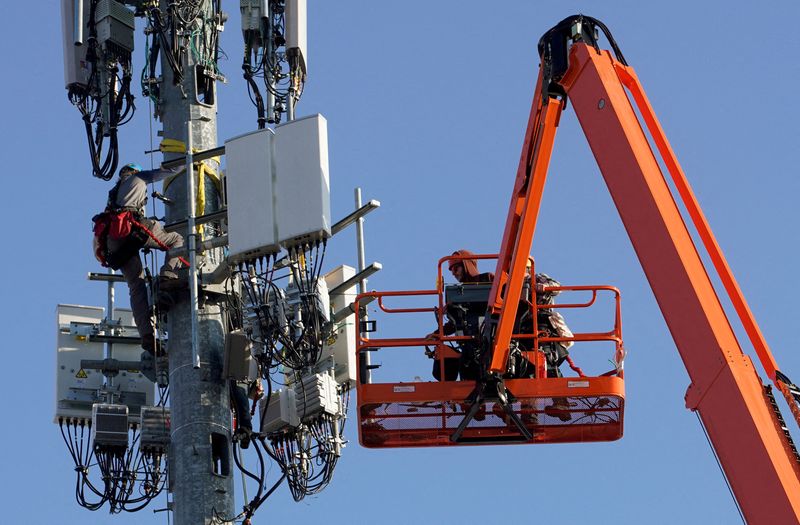(Reuters) - U.S. telecom companies and airlines have been fighting for weeks over the potential impact of 5G wireless services on aircraft, in stark contrast to the rollout of new-generation services elsewhere, which has broadly gone ahead without airing new safety concerns.
Here is some background on the dispute, in which Verizon Communications (NYSE:VZ) and AT&T (NYSE:T) agreed on Monday to a two-week delay in using newly acquired wireless spectrum, drawing back from a standoff that threatened to disrupt flights. The agreement promises to avert most, but not all, potential disruption to air travel from 5G deployment
WHAT IS THE PROBLEM?
The U.S. auctioned mid-range 5G bandwidth to mobile phone companies in early 2021 in the 3.7-3.98 GHz range on the spectrum, known as C-Band, for about $80 billion.
U.S. aviation industry groups in recent months stepped up concerns and the Federal Aviation Administration (FAA) issued a formal warning in November of the risk of interference with flight equipment.
In the airline industry, radar altimeters, which measure altitude, operate in the 4.2-4.4 GHz range and there are concerns that there is not a big enough buffer from the frequencies to be used by the telecoms companies.
The companies have faced pressure from the White House, airlines and aviation unions to delay the deployment amid concerns about potential interference of 5G with sensitive aircraft electronics like radio altimeters.
WHY IS THAT POTENTIALLY IMPORTANT FOR AVIATION?
Radio altimeters help to minimize the risk of accidents or collisions by giving an accurate reading of the proximity to the ground. The readouts are also used to facilitate automated landings and to help detect dangerous currents called windshear.
WHAT DIFFERENCE DOES THE FREQUENCY MAKE?
In short, the higher the frequency in the spectrum, the faster the service. So in order to get full value from 5G, operators want to operate at higher frequencies.
Some of the C-Band spectrum auctioned in the United States had been used for satellite radio but the transition to 5G means there will be much more traffic.
IS THIS A PROBLEM ELSEWHERE?
Following years of international discussions, the European Union in 2019 set standards for mid-range 5G frequencies in the 3.4-3.8 GHz range.
They have been auctioned and taken into use in many of the bloc's 27 member states so far without issue.
The European Union Aviation Safety Agency (EASA), which oversees 31 states, said on Dec. 17 the latest discussion was specific to U.S. airspace. "At this stage, no risk of unsafe interference has been identified in Europe," it said.
AT&T and Verizon have agreed to adopt exclusion zones around many U.S. airports similar to those used in France for six months.
FAA officials noted the spectrum used by France (3.6-3.8 GHz) sits further away from the spectrum (4.2-4.4 GHz) used for radio altimeters than in the United States and France's power level for 5G is also much lower than what is authorized in the United States.
But Verizon said it will not use spectrum that closer than what France is using for several years.
In South Korea, the 5G mobile communication frequency is 3.42-3.7GHz band and there has been no report of interference with radio wave since commercialization of 5G in April 2019.
Currently, 5G mobile communication wireless stations are in operation near airports, but there have been no reports of problems.
CTIA, a U.S. wireless trade group, said in a filing with the Federal Communications Commission that "wireless carriers in nearly 40 countries throughout Europe and Asia now use the C-Band for 5G, with no reported effects on radio altimeters that operate in the same internationally designated 4.2-4.4 GHz
band."
It added "each day U.S. aircraft, carrying thousands of U.S. citizens, land in these countries without incident and with no expression of concern by the FAA or foreign aviation regulators. This is the classic dog that did not bark. The laws of physics are no different in the United States than in Europe or Asia."
But airlines had warned that without an agreement the safety precautions could disrupt up to 4% of daily flights. An airline group said the issue had the potential "to divert or cancel thousands of flights every day, thus disrupting millions of passenger reservations, causing substantial disruptions."
United Airlines Chief Executive Scott Kirby (NYSE:KEX) said last month that left unresolved the interference issue would mean that at major U.S. airports in the event of bad weather, cloud cover or even heavy smog "you could only do visual approaches essentially."
